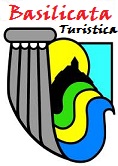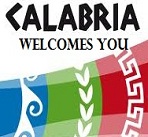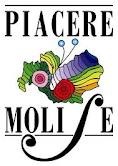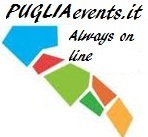
|
||||||||||||||||||||
Magna Grecia
Domenico Russumanno
  In ancient times, southern Italy was inhabited by the Oenotrians ("tribe led by Oenotrus"). In ancient times, southern Italy was inhabited by the Oenotrians ("tribe led by Oenotrus").A likely derivation of the ethnonym Oenotrian would be the Greek ο?νος (oinos), "wine", as the Oenotrians inhabited a territory rich in vineyards, with Oenotria (or Enotria) being extended to refer to the entirety of Southern Italy. By the sixth century BC, the Oenotrians had been absorbed by other Italic tribes. Ancient Greek writers stated that Oenotrians arrived there at the beginning of the Iron Age (11th century BC ) from Greece through the Strait of Otranto (Tarentum -Taranto - Apulia) together with other people of the same ethnic group, the first wave of Greek settlers. 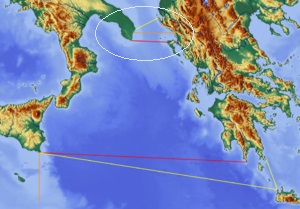
According to Antoninus Liberalis, their arrival triggered the migration of the Elymians to Sicily.
The settlement of the Greeks with the first stable colonies, such as Metapontum, founded on a native one (Metabon), pushed the Oenotrians inland. The ruins of Metapontum are located in the area of Metaponto, in the comune of Bernalda, in the Province of Matera, Basilicata region. 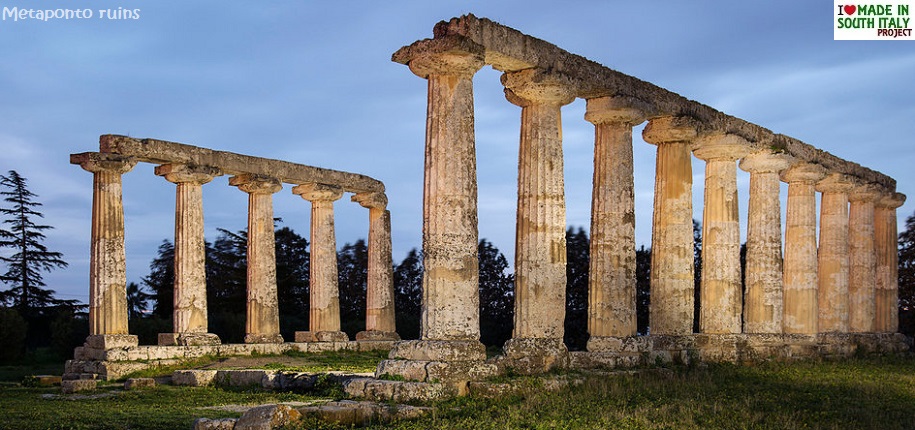 In the 8th and 7th centuries BC, for various reasons, including demographic crises (famine, overcrowding, etc.), the search for new commercial outlets and ports, and expulsion from their homeland, Greeks began to settle in southern Italy (Cerchiai, pp. 14–18).
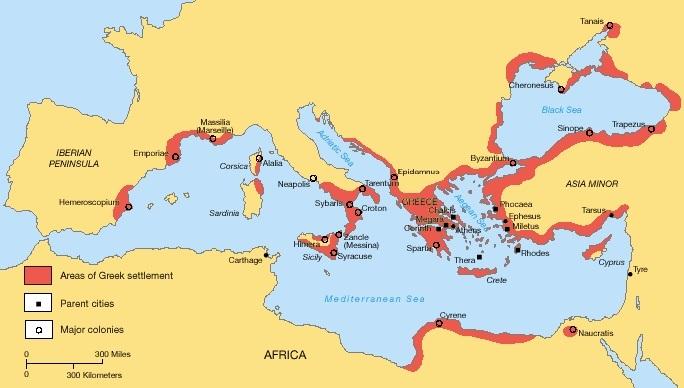 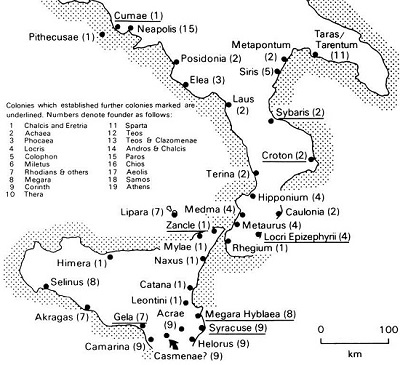 Also during this period, Greek colonies were established in places as widely separated as the eastern coast of the Black Sea, Eastern Libya and Massalia (Marseilles). Also during this period, Greek colonies were established in places as widely separated as the eastern coast of the Black Sea, Eastern Libya and Massalia (Marseilles). Greek colonization in southern Italy involved the regions of Apulia, Basilicata, Calabria, Campania and Sicily. Magna Græcia (Latin meaning "Great Greece", Greek: Μεγ?λη ?λλ?ς, Megál? Hellás) is the name of the coastal areas of Southern Italy that were extensively colonized by Greek settlers; particularly the Achaean colonies of Tarentum, Crotone, and Sybaris, but also, more loosely, the cities of Cumae and Neapolis to the north. 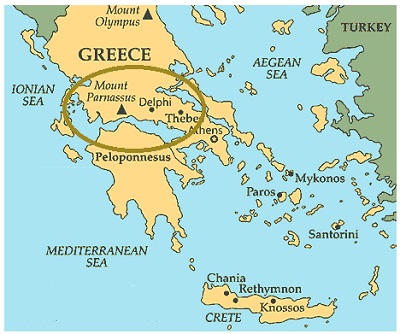 The colonists were led by a "ecista" a chosen leader, who before departure was sent to consult the Oracle Delphi (Delphi is both an archeological site and a modern town in Greece on the south-western spur of Mount Parnassus in the valley of Phocis), for instructions on where to found the new colony. The colonists were led by a "ecista" a chosen leader, who before departure was sent to consult the Oracle Delphi (Delphi is both an archeological site and a modern town in Greece on the south-western spur of Mount Parnassus in the valley of Phocis), for instructions on where to found the new colony.The inhabitants of these lands called themselves Italioti and Siceliots and brought with them their Hellenic civilization, which was to leave a lasting imprint in Italy, particularly on the culture of ancient Rome. With this colonization, Greek culture was exported to Italy, in its dialects of the Ancient Greek language, its religious rites and its traditions of the independent polis. 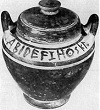 An original Hellenic civilization soon developed, later interacting with the native Italic civilizations. An original Hellenic civilization soon developed, later interacting with the native Italic civilizations. The most important cultural transplant was the Chalcidean/Cumaean variety of the Greek alphabet, which was adopted by the Etruscans; the Old Italic alphabet subsequently evolved into the Latin alphabet, which became the most widely used alphabet in the world. During the Early Middle Ages, new waves of Greeks came to Magna Graecia from Greece and Asia Minor, as Southern Italy remained governed by the Eastern Roman Empire. 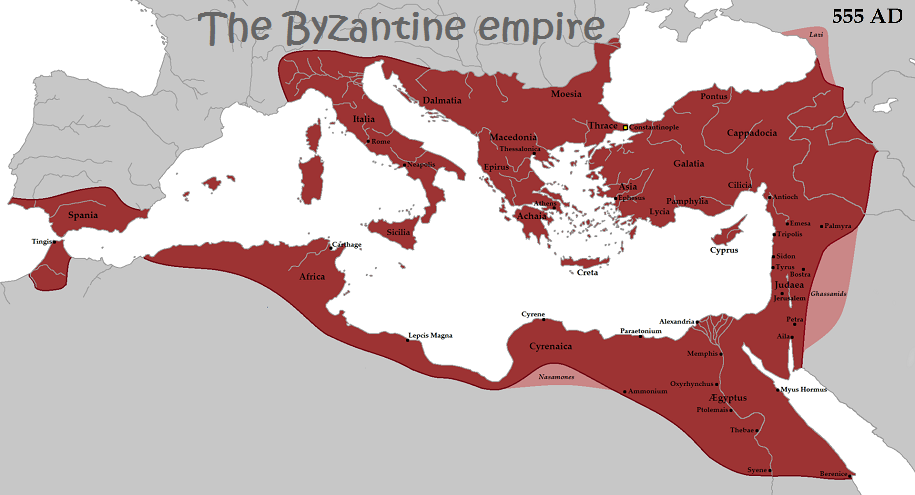 The Byzantine Empire, sometimes referred to as the Eastern Roman Empire, was the continuation of the Roman Empire in the East during Late Antiquity and the Middle Ages, when its capital city was Constantinople (modern-day Istanbul, originally founded as Byzantium). It survived the fragmentation and fall of the Western Roman Empire in the 5th century AD and continued to exist for an additional thousand years until it fell to the Ottoman Turks in 1453
 Delphi, the spiritual heart of ancient Greece.
The site of Delphi is located in upper central Greece, on multiple plateaux/terraces along the slope of Mount Parnassus, and includes the Sanctuary of Apollo, the site of the ancient Oracle.
This semicircular spur is known as Phaedriades, and overlooks the Pleistos Valley. Delphi was thought of by the Greeks as the middle of the entire earth. 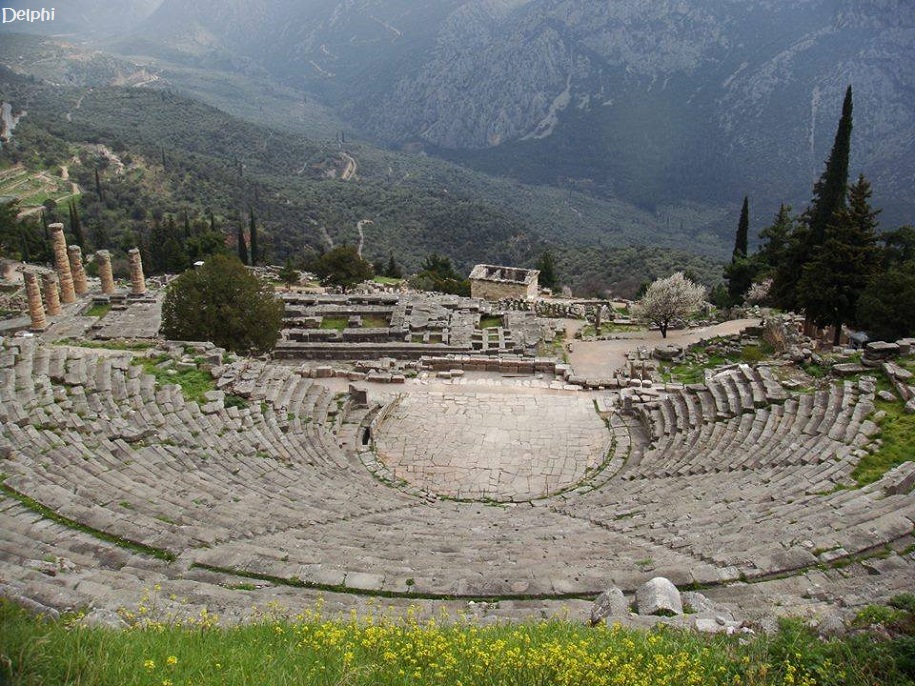 In myths dating to the classical period of Ancient Greece (510-323 BC), the site of Delphi was believed to be determined by Zeus when he sought to find the centre of his "Grandmother Earth".
Delphi is perhaps best known for the oracle at the sanctuary that was dedicated to Apollo during the classical period. Apollo spoke through his oracle: the sibyl or priestess of the oracle at Delphi was known as the Pythia. 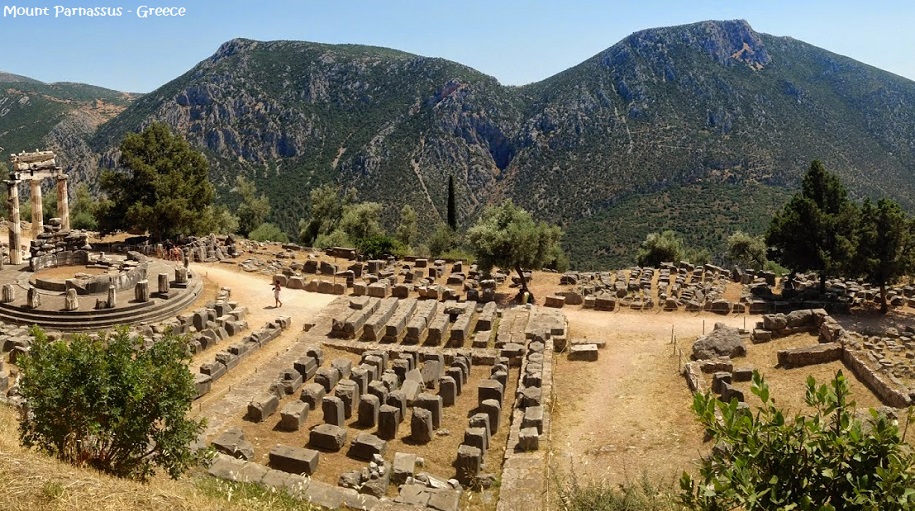 The Cumaean Sibyl was the priestess presiding over the Apollonian oracle at Cumae, the Greek colony located near Naples. The Cumaean Sibyl prophesied by “singing the fates” and writing on oak leaves. These would be arranged inside the entrance of her cave but, if the wind blew and scattered them, she would not help to reassemble the leaves to form the original prophecy again. The Sibyl was a guide to the underworld (Hades), its entry being at the nearby crater of Avernus. Aeneas employed her services before his descent to the lower world to visit his dead father Anchises. 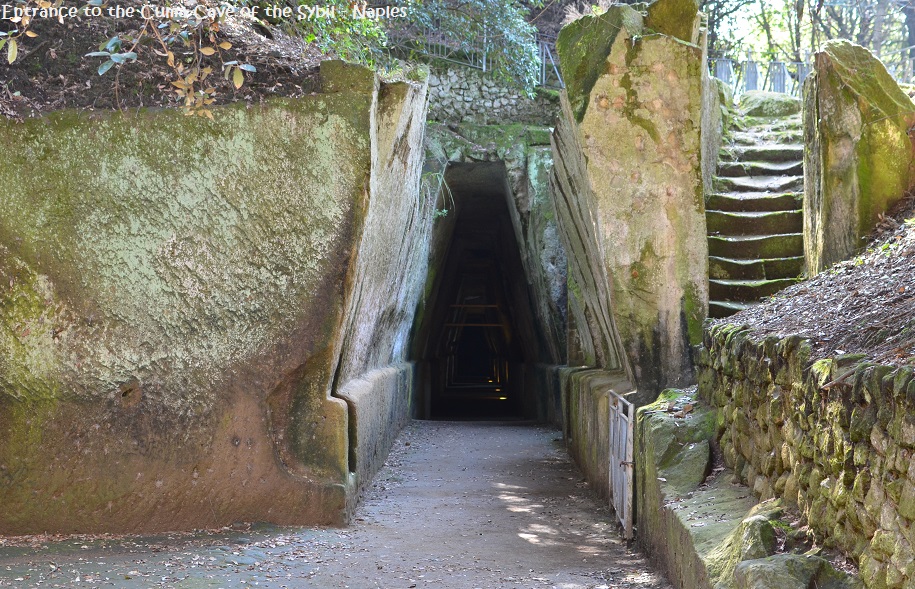  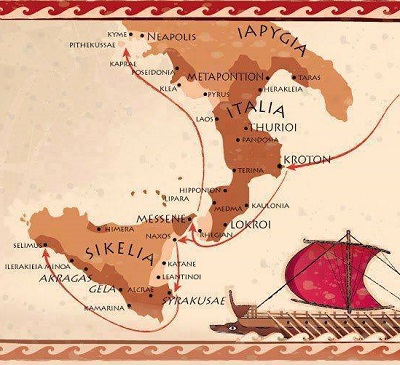 Griko is the name of a language combining ancient Doric, Byzantine Greek, and Italian elements, spoken by people in the Magna Graecia region. Griko is the name of a language combining ancient Doric, Byzantine Greek, and Italian elements, spoken by people in the Magna Graecia region.The most popular hypothesis on the origin of Griko is the one by Gerhard Rohlfs and Georgios Hatzidakis, stating that Griko's roots go as far back in history as the time of the ancient Greek colonisation of Southern Italy and Sicily and in that respect, this Southern Italian dialect is considered to be the last living trace of the Greek elements that once formed Magna Graecia. There is rich oral tradition and Griko folklore, limited now, though once numerous, to only a few thousand people, most of them having become absorbed into the surrounding Italian element. Records of Magna Graecia being predominantly Greek-speaking, date as late as the 11th century (the end of Byzantine domination in Southern Italy). The Calabrian Griko region also consists of nine villages in Bovesia, (including Bova Superiore, 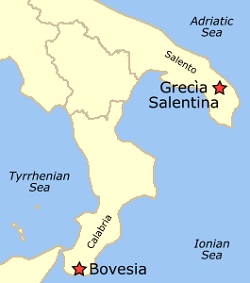
Roghudi, Gallicianò, Chorìo di Roghudi and Bova Marina) and four districts in the city of Reggio Calabria, but its population is significantly smaller, supposedly around 2000.? The Calabrian dialect of Greek, or Greek-Bovesian, is the variety of Italiot Greek used by the ethnic Griko people in Calabria, as opposed to the Italiot Greek dialect spoken in the Grecìa Salentina. They are frequently lumped together as Italiot Greek (Katoitaliótika), Grecanic or Griko, but they have different developmental histories.
Calabrian Greek is mentioned in the Red Book of UNESCO on endangered languages, together with Griko. In addition, Euromosaic analyzes and recognizes it as being an endangered and minority language in the European Union. It is mentioned by Ethnologue as a dialect of Modern Greek,in the sense of a modern vernacular language of the Hellenic family (as is the case with Pontic and Tsakonian Greek). However, Calabrian Greek has never experienced an extensive growth period during its history, and it has only ever been used in basic day-to-day communications, without ever playing a significant role in the fields of administration, literature, or ecclesiastical matters. 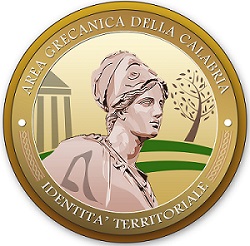 The Italiot-speaking area of Salento comprises nine small towns in the Grecìa Salentina region (Calimera, Martano, Castrignano de' Greci, Corigliano d'Otranto, Melpignano, Soleto, Sternatia, Zollino, Martignano), with a total of 40,000 inhabitants. The Griko music from Salento
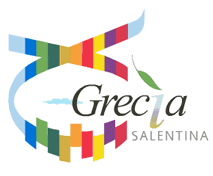 Are you considering visiting Southern Italy sometime soon or in the near future? Will you be traveling alone or with a tour? Can we be of any help? Would you like to share your past or future experience with us? Drop us a line. La vetrina ideale per promuovere i vostri prodotti e servizi sul mercato Nord Americano ma che potrebbe essere un punto di visibilità anche nei vari mercati internazionali.
AZIENDE - PRODUTTORI - STRUTTURE RICETTIVE - GUIDE TURISTICHE - TOUR OPERATORI Ai nostri visitatori piace il Sud Italia, vuoi dire loro qualcosa? Il nostro obiettivo e' quello di promuovere prodotti tipici del Sud in un contesto di marketing globale, e allo stesso tempo proporre il nostro Meridione come alternativa turistica, ben consapevoli che il successo dell'uno è essenziale per il successo dell'altro. Paesi di provenienza dei visitatori in ordine numerico Stati Uniti - Canada - Italia - Gran Bretagna - Australia - China - Germania - Francia - Nuova Zelanda - Olanda Coloro interessati ad inserire la loro attivita'/azienda/ nel sito
|
||||||||||||||||||||






